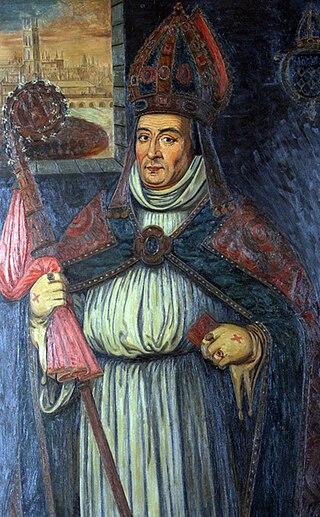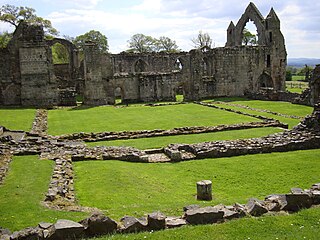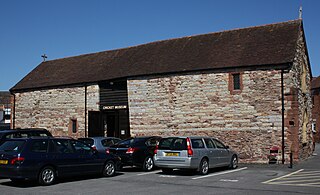Related Research Articles

An abbey is a type of monastery used by members of a religious order under the governance of an abbot or abbess. Abbeys provide a complex of buildings and land for religious activities, work, and housing of Christian monks and nuns.

The Cathedral Church of the Holy Trinity,Saint Peter, Saint Paul and Saint Swithun, commonly known as Winchester Cathedral, is the cathedral of the city of Winchester, England, and is among the largest of its kind in Northern Europe. The cathedral is the seat of the Bishop of Winchester and is the mother church for the ancient Diocese of Winchester. It is run by a dean and chapter, under the Dean of Winchester.

Gisborough Priory is a ruined Augustinian priory in Guisborough in the current borough of Redcar and Cleveland, North Yorkshire, England. It was founded in 1119 as the Priory of St Mary by the Norman feudal magnate Robert de Brus, also an ancestor of the Scottish king, Robert the Bruce. It became one of the richest monastic foundations in England with grants from the crown and bequests from de Brus, other nobles and gentry and local people of more modest means. Much of the Romanesque Norman priory was destroyed in a fire in 1289. It was rebuilt in the Gothic style on a grander scale over the following century. Its remains are regarded as among the finest surviving examples of early Gothic architecture in England.

William Waynflete, born William Patten, was Headmaster of Winchester College (1429–1441), Provost of Eton College (1442–1447), Bishop of Winchester (1447–1486) and Lord Chancellor of England (1456–1460). He founded Magdalen College, Oxford, and three subsidiary schools, namely Magdalen College School in Oxford, Magdalen College School, Brackley in Northamptonshire and Wainfleet All Saints in Lincolnshire.
In Christianity, a collegiate church is a church where the daily office of worship is maintained by a college of canons, a non-monastic or "secular" community of clergy, organised as a self-governing corporate body, headed by a dignitary bearing a title which may vary, such as dean or provost.

Haughmond Abbey is a ruined, medieval, Augustinian monastery a few miles from Shrewsbury, England. It was probably founded in the early 12th century and was closely associated with the FitzAlan family, who became Earls of Arundel, and some of their wealthier vassals and allies. It was a substantial, successful and wealthy house for most of its four centuries, although evidence of abuses appeared before its dissolution in 1539. The buildings fell into disrepair and the church was largely destroyed, although the remains of some of the domestic buildings remain impressive. The site is now in the care of English Heritage and is open to the public throughout the year and free entry.

A fan vault is a form of vault used in the Gothic style, in which the ribs are all of the same curve and spaced equidistantly, in a manner resembling a fan. The initiation and propagation of this design element is strongly associated with England.

Brinkburn Priory is a former monastery built, starting in the 12th century, on a bend of the River Coquet, about 4 miles (6 km) east of Rothbury, Northumberland, England.

Edington Priory in Wiltshire, England, was founded by William Edington, the bishop of Winchester, in 1351 in his home village of Edington, about 3+3⁄4 miles (6 km) east of the town of Westbury. The priory church was consecrated in 1361 and continues in use as the parish church of Saint Mary, Saint Katharine and All Saints.

Norton Priory is a historic site in Norton, Runcorn, Cheshire, England, comprising the remains of an abbey complex dating from the 12th to 16th centuries, and an 18th-century country house; it is now a museum. The remains are a scheduled ancient monument and are recorded in the National Heritage List for England as a designated Grade I listed building. They are considered to be the most important monastic remains in Cheshire.

The Augustinian Priory of St Mary, most commonly referred to as Bridgetown Priory and also as Bridgetown Abbey, is a ruined 13th-century Augustinian monastery of the Canons regular of St. Victor. It is located in Castletownroche, County Cork, Ireland near where the River Awbeg meets the Blackwater. Once an affluent monastery, it was dissolved by Henry VIII in 1541, and the ruins are currently managed by Cork County Council.

Taunton Priory, or the Priory of St Peter and St Paul, was an Augustinian house of canons founded c. 1115 by William Gyffarde, Bishop of Winchester and Chancellor of England near Taunton, Somerset, England.

Gresley Priory was a monastery of Augustinian Canons regular in Church Gresley, Derbyshire, England, founded in the 12th century.

Pamber Priory is a Church of England parish church and former priory, then known as West Sherborne Priory or Monk Sherborne Priory, at Monk Sherborne in the English county of Hampshire.

Kirby Bellars Priory was a small priory of Canons Regular of Saint Augustine in Leicestershire, England. It is now the Church of England Parish Church of Saint Peter's serving the village of Kirby Bellars.

Butley Priory, sometimes called Butley Abbey, was a religious house of Canons regular in Butley, Suffolk, dedicated to The Blessed Virgin Mary. It was founded in 1171 by Ranulf de Glanville, Chief Justiciar to King Henry II (1180-1189), and was the sister foundation to Ranulf's house of White canons (Premonstratensians) at Leiston Abbey, a few miles to the north, founded c. 1183. Butley Priory was suppressed in 1538.

Maxstoke Priory was an Augustinian priory in Warwickshire, England. The substantial remains are on Historic England's Heritage at Risk Register due to their poor condition.

The Abbey of Saint Mary de Pratis, more commonly known as Leicester Abbey, was an Augustinian religious house in the city of Leicester, in the East Midlands of England. The abbey was founded in the 12th century by the Robert de Beaumont, 2nd Earl of Leicester, and grew to become the wealthiest religious establishment within Leicestershire. Through patronage and donations the abbey gained the advowsons of countless churches throughout England, and acquired a considerable amount of land, and several manorial lordships. Leicester Abbey also maintained a cell at Cockerham Priory, in Lancashire. The Abbey's prosperity was boosted through the passage of special privileges by both the English Kings and the Pope. These included an exemption from sending representatives to parliament and from paying tithe on certain land and livestock. Despite its privileges and sizeable landed estates, from the late 14th century the abbey began to suffer financially and was forced to lease out its estates. The worsening financial situation was exacerbated throughout the 15th century and early 16th century by a series of incompetent, corrupt and extravagant abbots. By 1535 the abbey's considerable income was exceeded by even more considerable debts.

The Priory of Saint Mary, Clontuskert-Hy-Many, also called Clontuskert Abbey, is a medieval Augustinian priory and National Monument located in County Galway, Ireland.

Perpendicular Gothic architecture was the third and final style of English Gothic architecture developed in the Kingdom of England during the Late Middle Ages, typified by large windows, four-centred arches, straight vertical and horizontal lines in the tracery, and regular arch-topped rectangular panelling. Perpendicular was the prevailing style of Late Gothic architecture in England from the 14th century to the 17th century. Perpendicular was unique to the country: no equivalent arose in Continental Europe or elsewhere in the British-Irish Isles. Of all the Gothic architectural styles, Perpendicular was the first to experience a second wave of popularity from the 18th century on in Gothic Revival architecture.
References
- ↑ D. Le Faye, 'Selborne Priory, 1233-1486', Proc. Hampshire Field Club and Archaeological Society XXX (1973), pp. 47-71 (Society's pdf).
- ↑ W.D. Macray, Calendar of Charters and Documents relating to Selborne and its Priory, (Simpkin and Co. Limited, London/Warren and Son, Winchester 1891 and 1894), First Series and Second Series (Internet Archive).
- A History of the County of Hampshire: Volume 2, The Victoria County History 1973
- The Buildings of England: Hampshire and the Isle of Wight, Nikolaus Pevsner and David Lloyd, 1967
Baker, David and contributors 2014. Selborne Priory: Excavations 1953-71. Hampshire Field club Monograph 12, 248pp Abstract: The priory of Selborne in Hampshire was founded in 1233 for Augustinian canons by Peter des Roches, Bishop of Winchester, and dissolved in 1486 by his successor William Waynflete. A chantry chapel survived until about 1550. Excavations between 1953 and 1971, mostly by local volunteers, were stimulated by Gilbert White’s Natural History and Antiquities of Selborne (1789), but early work was confused by an assumption that the church lay north rather than south of the cloister. The cruciform church was largely completed by the mid-13th century: it had a long unaisled nave, transepts built with fully developed eastern chapels and an unextended presbytery. The west and north claustral ranges had undercrofts of seven bays with central free-standing piers. A two-bay chapter house was divided by an arcade; further north, the east range undercroft contained a square vaulted warming house or inner parlour. Graffiti on reused ashlar blocks in the drain for the canons’ latrine depicted a man, a horse and a crucifixion. Thirteen burials were found in four locations, six in stone coffins. Building materials include a fine foliate decorated roof boss from the presbytery, a quantity of mid-13th century grisaille glass, lead cames and window ties. A major collection of decorated medieval floor tiles is placed within Hampshire and wider contexts. Registered finds were mostly for domestic use rather than religious activity. 25 coins, tokens and jettons are reported. Eleven groups of ceramic wares include 15th and 16th century vessels for distillation and other alchemic practices already reported elsewhere. Documentary evidence is discussed including hitherto unpublished building repair accounts for the chantry in 1513–14. Reconstructions of the buildings are proposed in the wider context of Augustinian planning and by comparison with nearby contemporary Titchfield Abbey. Appendices note the excavation strategies, coffin lids at the parish church of St Mary, a 1490 inventory of church goods at the priory, and small scale excavations undertaken about 1900.